|
|
Among the various Types of Static Removal Devices available, corona discharge static removal devices are the most commonly used.
For static removal devices, there are also various types available based on the method of voltage application to the electrode needles. Examples are explained below.
A system that continuously applies either + or - DC voltage to the electrode needles.
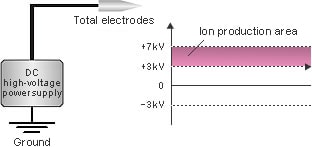
| Advantages |
|---|
| Fast static removal |
| Disadvantages |
| Can only remove static for one polarity. Satisfactory ion balance. |
A system that continuously applies AC voltage to the electrode needles.
Because it boosts commercial power sources, the ± ion production cycle is 50 or 60 Hz.
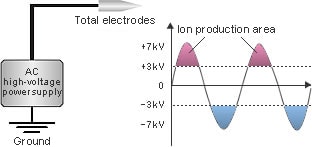
| Advantages |
|---|
| Because it alternately produces + and - ions, it has a good ion balance. |
| Disadvantages |
| Produces a low amount of ions and static removal is slow. Because the ion production cycle often recombines generated ions quickly, long distance mounting is not possible. |
A system that uses a piezo element to boost the AC voltage ±2 kV and applies that to the electrode needles at high-frequency.
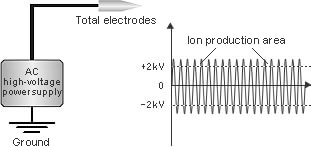
| Advantages |
|---|
| Good ion balance |
| Disadvantages |
| Because the voltage values of the piezo elements are low and therefore the amount of ions are low, static removal is slow. Dirt or abrasions on the electrode needles will cause it to quickly become unable to produce ions. Because the ion production cycle often recombines generated ions quickly, long distance mounting is not possible. |
DC voltage is alternately applied to a + and ? electrode. The + and ? electrodes are generally spaced evenly throughout the static eliminator.
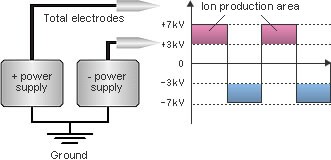
| Advantages |
|---|
| Produces a large amount of ions and static removal is fast. |
| Disadvantages |
| When using bar type static removal devices, ions in the longitudinal direction will have poor ion balance. Dirt or abrasions on the electrode needles will largely affect the speed of static removal and ion balance. |
Alternately switches between + and - DC voltage to each single electrode needle.
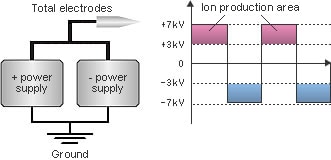
| Advantages |
|---|
| Produces a large amount of ions and static removal is fast. Because it alternately produces + and - ions, it has a good ion balance. |
| Disadvantages |
| None |
| Item | DC | Pulse DC | AC | High-frequency Wave AC | Pulse AC | |
|---|---|---|---|---|---|---|
| Discharge Frequency | Stationary/Continuous | Pulse 0.1 to 60 Hz | 50/60Hz | up to 70 KHz | Pulse 0.1 to 60 Hz | |
| Static removal speed | Short distance | Good | Good | Good | Very Good |
Very Good |
| Long distance | Good | Very Good |
Satisfactory | Satisfactory | Very Good |
|
| Ion balance | Short distance | N/A | Satisfactory | Very Good |
Very Good |
Very Good |
| Long distance | Good | Good | Good | Good | Very Good |
|